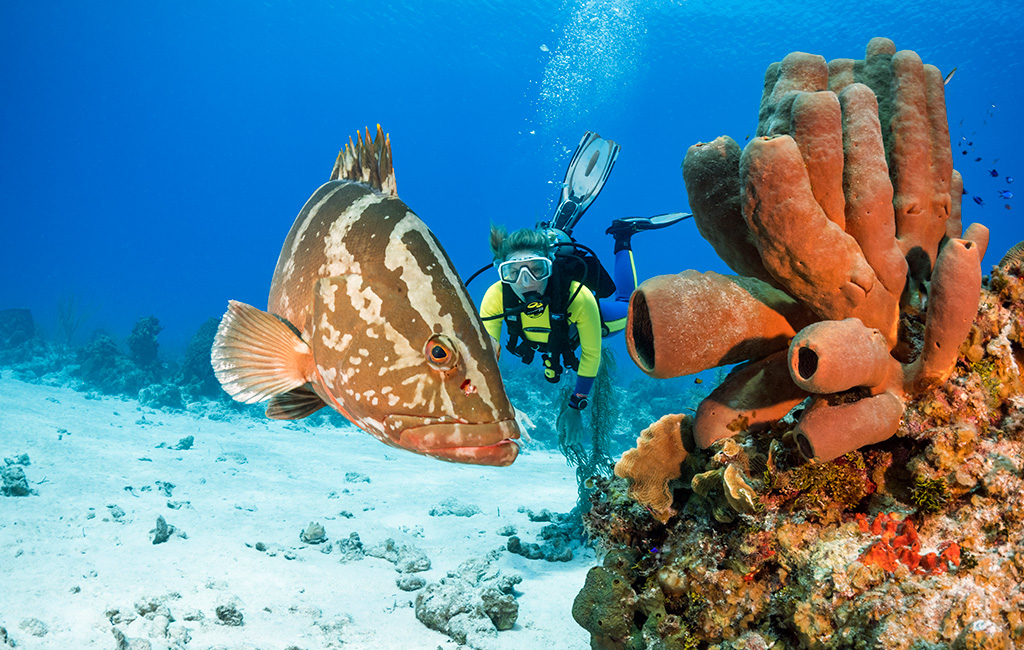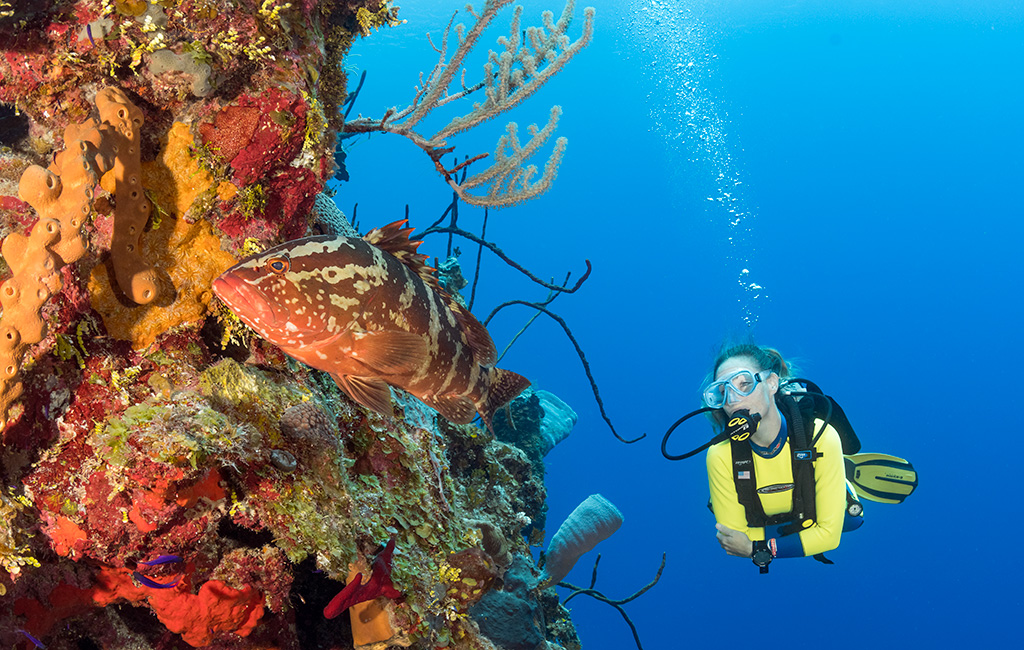
The Cayman Islands, the water will look clearer, the sand will feel softer, the dream will be worth the wait. In the interim start dreaming about a future dive adventure in the Cayman Islands with Caradonna. Discover the unmatched underwater diversity of the Cayman Islands, where a trio of islands are ringed by 365 unique dive sites — you can literally experience a different underwater adventure every day of the year. Cruise big walls, navigate coral grottoes, explore shipwrecks, discover fish-laden pinnacles or just hang out on sunlit shallow reefs. This destination offers something for everyone from new divers to scuba veterans, underwater photographers, wreck enthusiasts, critter seekers, and technical divers.
Divers come from around the world to experience the sheer underwater precipices of Bloody Bay Wall and other famous sites surrounding Little Cayman. The dramatic underwater landscapes are certainly the big draw, but divers often find a bonus in the form of some curious and often quite friendly groupers. On any given day, bubble-blowing humans may find themselves in the company of one or more vividly-striped fish that seem quite content to tag along. These are the Nassau Groupers that have long been a part of the island's diving experience.

Nassaus are among the middleweights of the grouper family, with most weighing in around 30 pounds. You can often find them around vertical sections of a reef or a sheltered area of a shipwreck. Once a Nassau finds a favorite spot, it spends most of the day idling in place, waiting for something tasty to swim by. When a meal wanders within range, a Nassau will gulp it in whole with a powerful suction created by opening it’s wide mouth. Because these ambushes take place mostly at dusk and dawn, when things on the reef are just waking up or going to bed, divers usually don't see Nassaus feeding. There was a time when it was standard practice for divers and underwater photographers to lure Nassaus in with a snack, and this practice led to one of the more storied animal encounters in the Caribbean.
Beginning in the 1980s, underwater photographers visiting Little Cayman would tempt Nassaus to come close with proffered offerings. The fish soon learned to associate divers with an easy meal, and sites such as Marilyn's Cut became known as the home of the friendly groupers. One particularly outgoing grouper that came to be known as Ben would actually initiate contact and allow divers to pet its flanks. Other gregarious Nassaus were assigned names like Jerry and Charlie, and their interactions with divers became a signature attraction at certain dive sites. As we learned more about preserving marine life and maintaining sustainability, we now recommend not touching marine life.

Then, in the late '90s, divers began to notice the absence of Nassaus on the reef. And it was the same story in other areas of the Caribbean and Tropical Atlantic, including the Bahamas and the Florida Keys, where these once-ubiquitous fish were becoming a rarer sighting.
Nassaus live solitary lives until it’s time to make some babies. When spawning season rolls around, these fish will gather by the hundreds and sometimes thousands, with some individuals swimming as much as a hundred miles or more to join the party. These spawning events take place during the full moon in winter months.

As Nassau Grouper numbers declined across the Caribbean and tropical Atlantic, the REEF Organization took action. In the winter of 2002, they launched the Grouper Moon Project, a research program that tracked annual spawning aggregations off the western shore of Little Cayman. Working with the Cayman Islands Department of Environment and Scripps Institution of Oceanography, the REEF scientists came to a troubling conclusion: the local grouper populations were dwindling, and targeted fishing practices were at least partially to blame. Efforts to protect these fish gained ground thanks to divers, as one of the major talking points in favor of conservation was that a live fish on the reef yielded far more revenue from dive tourism than the same fish served in a grouper sandwich.
Reacting to news of the decline, in 2003 the Cayman Islands government enacted fishing bans and created other protections for Nassau groupers, and in the years since added a number of no-take zones, marine preserves and seasonal fishing bans. As a result of these ongoing conservation efforts, the Nassau Grouper population in the waters of Little Cayman have rebounded and more than tripled in the past decade. In addition, divers are also reporting a growing population of resident Nassaus in the waters of nearby Cayman Brac.

Today, due to a no touching recommendation and conservation practices, Nassau Grouper are once more becoming a common sight in the waters of the Cayman Sister Islands. It's an inspiring success story for these colorful reef fish, and a reminder that divers can play an important role in the health of the oceans